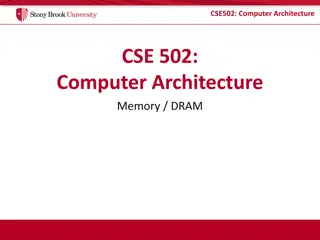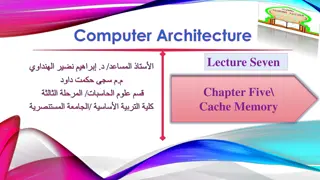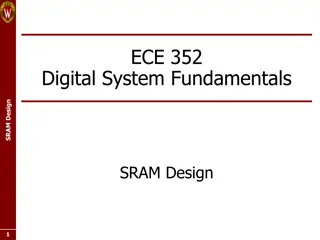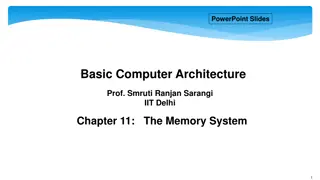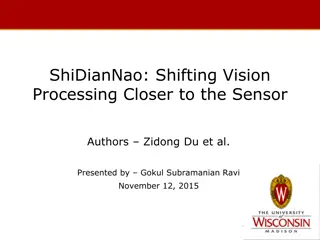Computer Architecture: Understanding SRAM and DRAM Memory Technologies
In the field of computer architecture, SRAM and DRAM are two prevalent memory technologies with distinct characteristics. SRAM retains data as long as power is present, while DRAM is dynamic and requires data refreshing. SRAM is built with high-speed CMOS technology, whereas DRAM is more dense and b
3 views • 38 slides
Understanding Cache Memory in Computer Architecture
Cache memory is a crucial component in computer architecture that aims to accelerate memory accesses by storing frequently used data closer to the CPU. This faster access is achieved through SRAM-based cache, which offers much shorter cycle times compared to DRAM. Various cache mapping schemes are e
2 views • 20 slides
Memory Design Overview: SRAM Cell and Bit Slice Organization
This content provides an overview of SRAM (Static Random Access Memory) cell and bit slice organization, explaining the design elements such as SRAM cell augment, D latch tristated output, multiple enable signals, row and bit selection, data input and output, addressing, and memory expansion with mu
0 views • 25 slides
Cutting-Edge Analog IPs for High-Density SRAM and GPIO
Explore the latest advancements in analog IPs showcased at AMICSA 2018, including high-density Dual Port SRAM, General Purpose IO with local POC, Voltage Monitor, and more. Dive into the details of technology, features, and specifications for these cutting-edge designs. Discover how these innovation
0 views • 18 slides
Understanding Memory System Design Tradeoffs in Computer Architecture
Explore the complexities of designing a memory system for computer architecture. Delve into the tradeoffs between area, power, and latency, considering the limitations of using only flip-flops, SRAM cells, or DRAM cells. Discover the challenges in creating an efficient memory system that balances st
0 views • 88 slides
ShiDianNao: Advancing Vision Processing Closer to Sensors
Neural network accelerators are achieving high energy efficiency and performance for recognition and mining applications. To overcome memory bandwidth constraints, the proposal suggests mapping the entire CNN into SRAM and moving closer to sensors to minimize memory access for I/O. Placing the CNN a
0 views • 24 slides
